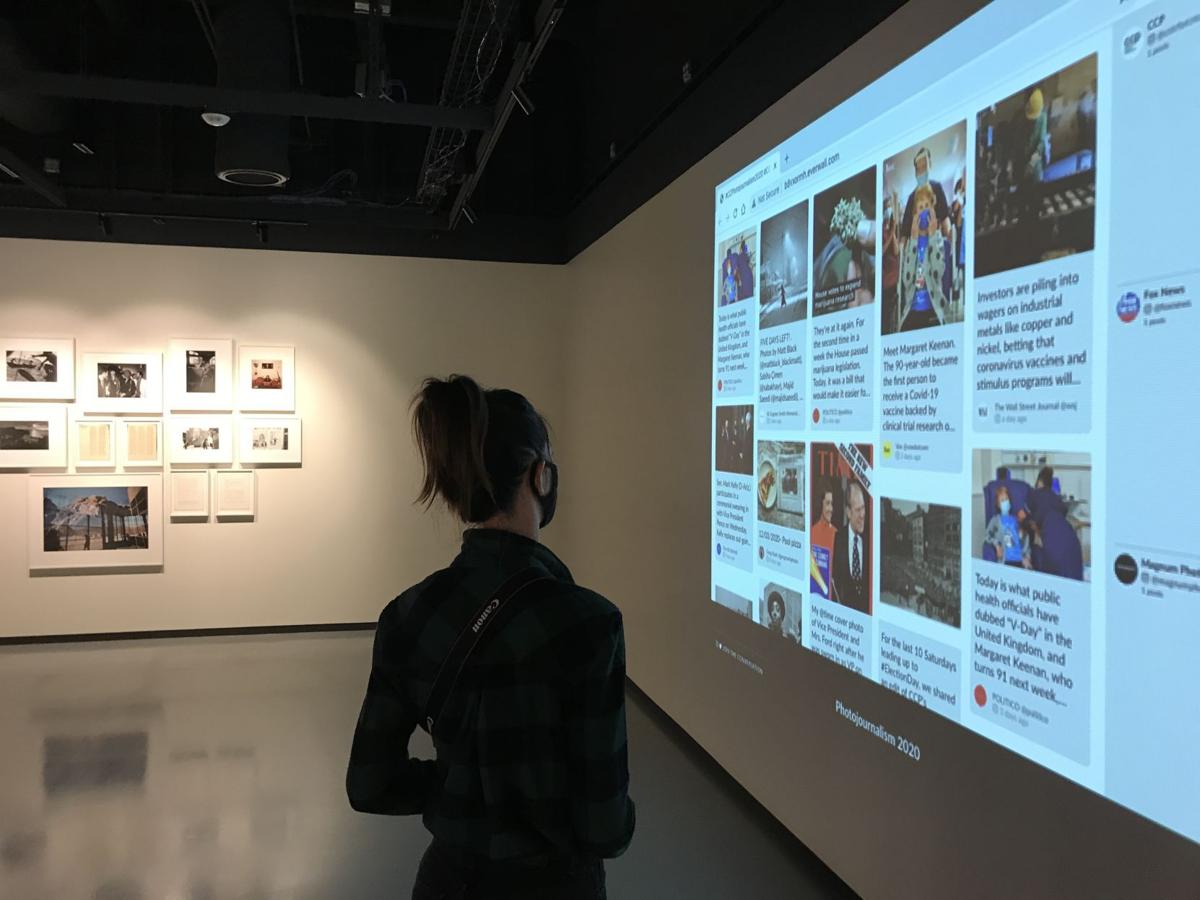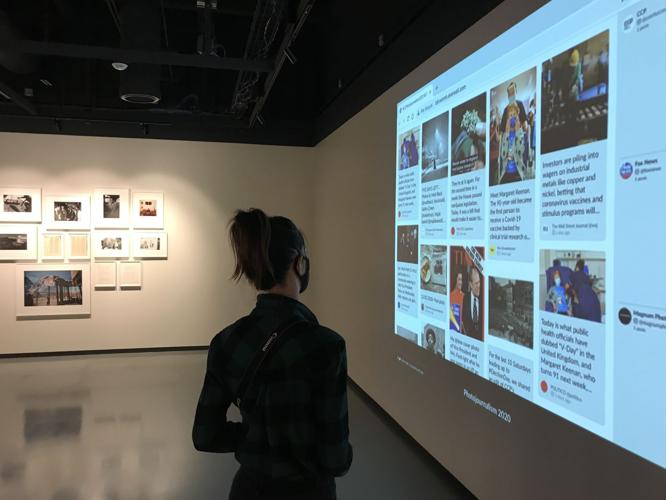Sen. Robert F. Kennedy’s hand gesture seems to signal he’s making a specific, important point to a crowd of Black supporters in David Hume Kennerly’s photo from a Kennedy 1968 presidential primary campaign stop in the Watts section of Los Angeles.
A Black couple sits near the back of a Chicago bus. The woman rests her head on the chest of a man who drapes his arm around her shoulders in the 1967 “Love on the Bus” by John Simmons.
Precisely coifed Margaret Bourke-White, the first female American war photojournalist, wears a crisp blouse with a necktie and military-style jacket as she sits in front of a world map and is surrounded by images of soldiers and battle in a 1942 image by Louise Dahl-Wolfe.
Each of these photographs captures a moment in time that both tell a story and evoke questions of what was happening at the time and how they relate today.
People are also reading…
What was Kennedy saying? How would his words be received today? How have politicians’ comments affected the civil rights movement?

John Simmons’ 1967 “Love on the Bus” is featured in the University of ĂŰÁÄÖ±˛Ąâ€™s Center for Creative Photography exhibit “Photojournalism 20/20.”
What are the young, Black couple on the bus feeling? Are they exhausted, pensive, discouraged or fearful? What kind of future were they hoping for?
How was Bourke-White treated in what was a man’s career field? Did she bust through a glass ceiling?
Examining the multiple layers and thought-provoking impacts of such single moments and exploring social questions are the focus of a new gallery and complementary interdisciplinary exhibits at the University of ĂŰÁÄÖ±˛Ąâ€™s Center for Creative Photography.
Recognizing the importance of serving and interacting with students and the community, the center has expanded photographic education to be more accessible and collaborative, says Anne Breckenridge Barrett, the director of the center and associate vice president for the arts at the University of ĂŰÁÄÖ±˛Ą. This gallery complements that goal.
The 2,131-square-foot Alice Chaiten Baker Interdisciplinary Gallery, the first physical expansion of the CCP’s on-site gallery space in over 20 years, aims to elevate interdisciplinary approaches to researching, learning and thinking about photos and photographic collections. Its exhibitions and activities will explore pertinent questions through photography, such as how images shape lives, and can the arts influence change?
When health restrictions are lifted and the center’s doors reopen to the public, visitors will discover the new gallery’s expanse through a soaring, retractable glass wall and concrete columns on the north side of the CCP entrance on North Olive Road.

The 2,131-square-foot Alice Chaiten Baker Interdisciplinary Gallery is the first physical expansion of the Center for Creative Photography’s on-site gallery space in over 20 years.
The gallery’s flexible, open space makes it conducive to a variety of activities, such as lectures, discussions, classes and gatherings, says Breckenridge Barrett.
Construction on the gallery continued during the COVID-19 shutdown and wrapped up in the late summer, says Breckenridge Barrett.
In addition to the gallery space, the remodel streamlined some of the center’s layout, such as moving the digital imaging department upstairs to avoid moving archival materials in the elevator and through heavily trafficked hallways.
Among the post-pandemic plans for the gallery is a 2022 interdisciplinary exhibit with the UA Laboratory of Tree-Ring Research, says Meg Jackson Fox, the center’s associate curator of academic and public programs. The tree-ring lab, which uses photography extensively, will exhibit photos, equipment and research materials.
The pandemic safety protocols shuttered the physical doors of the center and the center staff grabbed the opportunity to break out of museum walls by mounting the timely virtual exhibition, “Photojournalism 20/20: A Think Tank for an Unimaginable Present,” says Breckenridge Barrett.

This 1942 image by Louise Dahl-Wolfe of Margaret Bourke-White is featured in the new virtual exhibit. Bourke-White was the first-known female American war photojournalist.
With photojournalism and citizen photojournalism shaping public opinion, policy and history, the center’s think-tank-like study of photojournalism in “Photojournalism 20/20,” uses photography, essays and journals drawn from the center’s collection to present ideas that challenge perceptions.
The tone of “Photojournalism 20/20” is set in using the American Optometric Association quote: “Having 20/20 vision does not necessarily mean you have perfect vision. 20/20 vision only indicates the sharpness or clarity of vision at a distance.”
The exhibit then seeks that clarity by taking a deep dive into pertinent and heady topics: Discussion of Simmons’ “Love on the Bus” and other photojournalists who tell stories; the impact of photos on public opinion and the ethics of presenting these images; the relationship between memory and photography; and the problems weighing photojournalism, such as publishing shocking or controversial photographs.
The center has ramped up its social media presence, primarily through photo-centric Instagram, says Jackson Fox. In the 10 weeks leading up to Election Day 2020, the center shared images of photography in U.S. political culture. That collection is available for viewing at “Photojournalism 20/20.”

David Hume Kennerly’s photograph of Robert Kennedy during a 1968 campaign in Los Angeles is part of the UA Center for Creative Photography’s virtual exhibit “Photojournalism 20/20.”
The center is “installing the digital back into the physical space,” says Jackson Fox. The gallery’s north wall is planned as the center’s “social wall,” which will have large-scale projections of current news and images from social media.
The gallery is named in recognition of CCP donor, Tucson philanthropist and arts patron Alice Chaiten Baker. You may have heard that name before: The Alice Chaiten Baker Center for Art Education at the Tucson Museum of Art, nestled in historic downtown, opened in January 2020.
The Center for Creative Photography was co-founded in 1975 by then-UA President John Schaefer and photographer Ansel Adams. The collection includes over 200 archives and over 8 million archival objects, such as negatives, work prints, contact sheets, albums, scrapbooks and correspondence. There are currently more than 100,000 works by over 2,200 photographers.
Former ĂŰÁÄÖ±˛Ą Daily Star reporter and editor Ann Brown first visited the Center for Creative Photography in 1976 when it was housed in retail space on Park Avenue near the Main Gate Square.

















